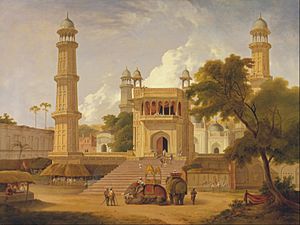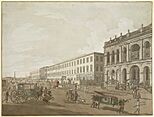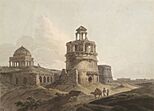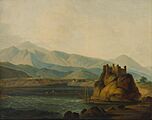Thomas Daniell facts for kids
Quick facts for kids
Thomas Daniell
|
|
|---|---|

Portrait of Thomas Daniell, date unknown
|
|
| Born | 1749 Kingston upon Thames, Surrey, England
|
| Died | 19 March 1840 Earls Terrace, Kensington, England
|
| Nationality | English |
| Education | Queen Street, London; Royal Academy |
| Known for | Painter, author, illustrator |
| Movement | Orientalist |
Thomas Daniell (1749–19 March 1840) was an English artist famous for painting landscapes. He also created art with "Orientalist" themes, which means he focused on scenes and people from countries like India and the Middle East. Thomas spent seven years in India with his nephew, William Daniell, who was also an artist. Together, they made many beautiful prints of the country.
Early Life and Art Journey
Thomas Daniell was born in 1749 in Kingston upon Thames, England. His father ran a local inn. Thomas started his art career by learning to paint coats of arms and symbols for families. He also worked painting coaches before going to the Royal Academy Schools, a famous art school.
Even though he showed many of his paintings – mostly landscapes and flowers – at the Academy between 1772 and 1784, it was hard for Thomas to become a well-known landscape painter in Britain. At that time, many Europeans heard exciting stories about India, a place that was becoming easier to visit. They hoped to find wealth and fame there. In 1784, Thomas got permission from the East India Company (a powerful British trading company) to travel to Calcutta, India. He planned to work there as an engraver, someone who makes pictures by carving them onto metal plates. His nephew, William Daniell, went with him as his helper.
Adventures in India

Thomas and William Daniell left England on April 7, 1785. They sailed to Calcutta, India, arriving in early 1786 after stopping in China. In July of that year, Thomas announced in a local newspaper that he planned to publish a collection of pictures of Calcutta. These pictures were made using special printing techniques called etching and aquatint, and then colored by hand by local painters. The twelve pictures were finished by late 1788. Thomas later wrote that he had to do all the work himself, from painting to printing, calling it "a devilish undertaking."
On September 3, 1788, the Daniells began a long journey through north-west India. They traveled by boat along the River Ganges, going as far as Srinagar. Thomas and William spent time in the town of Bhagalpur with a scholar and artist named Samuel Davis. They made many stops on their way back, finally reaching Calcutta in February 1792.
Soon after, on March 10, 1792, the Daniells left Calcutta again, this time for Madras (now Chennai). They arrived there on March 29. After only 11 days, they set off on another journey with a large group of helpers, including people to carry their special covered seats called palanquins. They followed a route similar to one the British army had used. They returned to Madras in January 1793. Their third, shorter trip took them through western India. They left Madras in mid-February 1793 and reached Bombay the next month. In May 1793, the Daniells left India and returned to England, arriving home in September 1794.
Back in England
When he returned to England, Thomas Daniell started publishing a huge collection of illustrated books called "Oriental Scenery." These books, published between 1795 and 1808, had drawings the Daniells made in India. There were 144 pictures in total, showing many different scenes.
The Daniells also published books with pictures of Egypt and a "Picturesque Voyage to India, by Way of China." They made almost all the prints themselves using the aquatint technique, which makes prints look like watercolor paintings. Thomas continued to show his Indian-themed artwork until 1828.

Thomas also helped design some gardens and buildings. He created an Indian temple for a friend's estate and various garden buildings for Sezincote, a famous house with Indian-style architecture. His paintings of Sezincote are special because most of his other work after returning to England was about India. He became a member of the Royal Academy in 1790, which is a big honor for an artist.
Thomas Daniell never married. He passed away at his home in Kensington, England, on March 19, 1840, at the age of 91. He is buried at Kensal Green Cemetery.
Gallery
-
Old Court House and Writers Building, Calcutta (1786)
-
Sambhal Jama Masjid, wash drawing by Thomas Daniell & William Daniell, 1789
-
Shivala Ghat, Benares, 1789
-
Hindu temples on the river at Jumna, India, 1795
-
Feroz Shah Kotla remains, Delhi, Aquatint, 1795, later reproduced on a Staffordshire earthenware dish c. 1810–20
-
The Rope Bridge at Serinagur, c. 1800
-
Taj Mahal, 1801
-
Mountain of Ellora, 1803
-
Dasavatara cave, Ellora, 1803
-
Viswakarma, Ellora, a chaitya worship hall built around 650 CE, by Thomas Daniell and James Wales, 1803
See also
- List of Orientalist artists
- Orientalism
- James Forbes (artist)

















